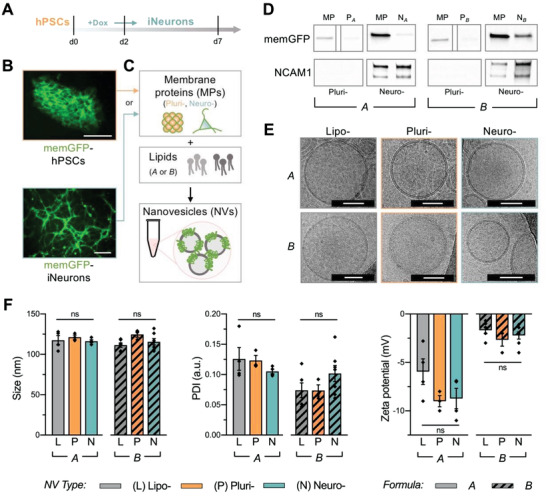Figure 1.

Physiochemical and biomimetic characterization of neural biomimetic NVs. A) iNeurons were directly generated from a genetically engineered human pluripotent stem cell (hPSC) line containing a doxycycline (dox)‐inducible neurogenin 2 (ngn2) transgene. A pure population was obtained within 7 days of differentiation. B) A stable membrane‐bound green fluorescent protein (memGFP) transgene was incorporated into the hPSC line to track protein carry‐over. Scale: 100 µm. C) A microfluidic approach was utilized for the synthesis of neural biomimetic NVs with cell‐specific membrane proteins and two different lipid formulations (i.e., A and B). Three NV groups were fabricated using each lipid formulation: “liposomes” (lipo‐, L) containing no protein, “plurisomes” (pluri‐, P) containing hPSC‐derived proteins, and “neurosomes” (neuro‐, N) containing iNeuron‐derived proteins. D) Immunoblotting revealed the transfer of mem‐GFP in plurisomes and neurosomes (NVs originating from hPSCs and iNeurons, respectively) as well as the transfer of neuronal membrane protein (MP) marker NCAM1 in neurosomes of both formulations. (Bands are replicated from Figure S1E (Supporting Information), with dividing lines indicating splicing from original image.) E) Cryo‐TEM images illustrated that all NV formulations had similar lipid bilayer morphologies containing a spherical bilayer structure. Scale: 50 nm. F) Physiochemical properties including NV size, PDI, and zeta potential were assessed. Though neither NV size nor PDI were significantly altered between NVs of different lipid formulations, NVs from lipid formulation B displayed a less negative zeta potential (n = 3–7 independent NV batches per group; see Figure S1F in the Supporting Information). For Figure 1F, results are shown as mean ± SEM. One‐way ANOVA followed by Tukey's multiple comparison test was used to determine statistical probabilities between NVs of different protein sources within the same formulation (A or B), with *p < 0.05.
